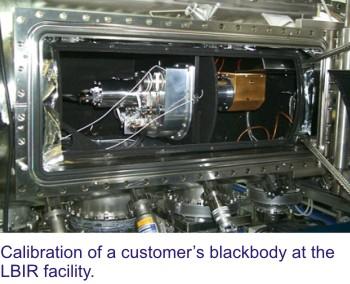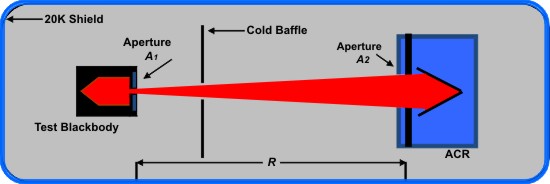Summary
The Missile Defense Agency (MDA) requires all test facilities to have their blackbodies calibrated at the NIST Low Background Infrared (LBIR) facility. The infrared test chambers for MDA are equipped with blackbody sources with pinhole apertures to emulate point sources in space. The NIST LBIR facility provides radiometric calibrations of these blackbodies so that various government test facilities as well as contractor facilities for MDA have a common NIST traceability.
Description

The broadband chamber and the spectral calibration chamber at the LBIR facility are used for calibrating the customer cryogenic blackbodies. These chambers are cooled by closed cycle helium gas at 20 K to provide a background equivalent to space. The absolute cryogenic radiometers (ACRs) in these chambers measure absolute optical power. These measurements combined with the physical dimensions of the various components in the optical geometry are the basis of the calibration.

The schematic above depicts the relevant aspects of the calibration of such blackbodies. The blackbody illuminates a precision aperture of area A1 through which radiation passes to the limiting aperture of area A2 of the ACR input. Radiant power measurements (in watts) are acquired by the ACR for all of the blackbody's various temperature settings and converted to radiance temperatures. Assuming a Lambertian blackbody, the radiance temperature is determined from the following equation deduced from the Stefan-Boltzmann law:
$$T=\left[\frac{E_0}{A_1F_1\sigma_M}\right]^{1/4}$$
where
$$F_1=\frac{1}{2}\left[z-\left[z^2-4x^2y^2\right]^{1/2}\right]$$
and
$$x=\frac{r_2}{R},\:y=\frac{R}{r_1},\:z=1+\left[1+x^2\right]y^2$$
In the above equations, r1 is the radius of the blackbody aperture, r2 is the radius of the ACR defining aperture, R is the distance between the apertures, A1 is the area of the blackbody aperture, E0 is the power, and σ M = 5.67051 x 10-12 W cm-2 K-4 . Because diffraction is introduced by the pinhole apertures, the power, E0, measured by the ACR is corrected. Calculation of the diffraction correction is based on the geometry of the calibration setup.
The calibration report provides the customer with the total radiant power measured at the ACR aperture and the corresponding deduced blackbody radiometric temperature. In general, the blackbody may have many apertures on a wheel and the measurements are done for each aperture and are reported for each of the requested blackbody apertures and the blackbody control temperature settings. A thorough analysis of the Type A and Type B uncertainties in the reported results are also provided. A typical blackbody calibration is described in the article listed below under Selected Publications, "Cryogenic blackbody calibrations at the National Institute of Standards and Technology (NIST) Low background infrared (LBIR) facility."
Major Accomplishments
The LBIR facility has been providing blackbody calibrations to customers for the last 25 years. The calibrations are performed as special tests based on customer requirements. The current customers are: Raytheon Missiles and Defense for the GM and AB programs, Johns Hopkins Applied Physics Laboratory for the AB program, and Arnold Engineering Development Complex for the GM program.

